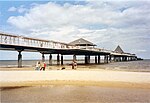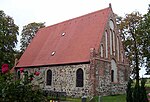Ahlbeck, Heringsdorf
Populated coastal places in Germany (Baltic Sea)Seaside resorts in GermanyVillages in Mecklenburg-Western Pomerania

Ahlbeck is a village (Ortsteil) of the Heringsdorf municipality on the island of Usedom on the Baltic coast. It is the easternmost of the so-called Kaiserbäder ("Imperial Spas") seaside resorts on the German part of the island, situated right next to the border with Poland and the city of Świnoujście. Both communities are freely connected by the longest beach promenade in Europe spanning more than 12 km (7 mi) from Bansin to Świnoujście.
Excerpt from the Wikipedia article Ahlbeck, Heringsdorf (License: CC BY-SA 3.0, Authors, Images).Ahlbeck, Heringsdorf
Korswandter Weg, Heringsdorf
Geographical coordinates (GPS) Address Nearby Places Show on map
Geographical coordinates (GPS)
| Latitude | Longitude |
|---|---|
| N 53.933333333333 ° | E 14.183333333333 ° |
Address
Korswandter Weg 20b
17419 Heringsdorf
Mecklenburg-Vorpommern, Germany
Open on Google Maps










